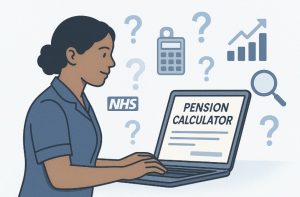Understanding NHS pension contribution rates is essential for healthcare staff planning their financial future.
With recent reforms and a tiered structure based on actual pensionable pay, employees need clear, up-to-date information on how their earnings affect their contributions.
This guide breaks down the latest changes, rules, and examples effective from April 2025, focusing on England and Wales.
Whether working full-time, part-time, or across multiple roles, NHS staff must be aware of how these rates influence their pension benefits.
What Are NHS Pension Contribution Rates And How Do They Work?

NHS pension contribution rates refer to the percentage of an employee’s pensionable salary that must be paid into the NHS Pension Scheme.
Both employees and employers contribute towards this scheme, ensuring a structured and secure pension for NHS staff upon retirement.
Employee contribution rates are determined by actual pensionable pay, not gross income or whole-time equivalent pay.
Pensionable pay usually includes basic salary and any regularly paid enhancements such as unsocial hours payments. One-off bonuses or overtime typically do not count.
Employer contributions are set at a fixed rate and are significantly higher than employee contributions.
Currently, the employer pays 20.6% of the employee’s pensionable pay, plus an administration levy.
Key aspects of how the system works include:
- Contributions are automatically deducted from monthly pay
- Rates are based on actual earnings, not notional full-time figures
- Pension benefits are calculated under a defined benefit scheme, not based on the amount paid in
How Have The NHS Pension Contribution Rates Changed Recently?
The NHS pension contribution structure has undergone reforms in stages from 2022 to 2025. The primary goal of these changes is to make the system more equitable and to ensure it reflects actual earnings, which is especially important for part-time staff.
Previously, contribution rates were based on whole-time equivalent earnings. This often resulted in part-time staff paying a higher rate than their actual earnings warranted.
The revised structure introduced in October 2022 uses actual annual pensionable pay instead.
Reforms also adjusted the earnings bands and corresponding contribution rates. These adjustments are phased and are reviewed annually to reflect changes in the cost of living and average earnings.
The final phase of the changes is scheduled for 1 April 2025. At that point, the full banded contribution system will be in effect.
What Are The Current NHS Pension Contribution Tiers For 2024/2025?
From 1 April 2025, the NHS Pension Scheme in England and Wales operates with six contribution bands. The rates apply to all members based on their actual pensionable earnings.
NHS Pension Contribution Tiers (Effective 1 April 2025)
| Annual Pensionable Pay | Employee Contribution Rate |
| Up to £13,259 | 5.2% |
| £13,260 to £27,797 | 6.5% |
| £27,798 to £33,868 | 8.3% |
| £33,869 to £50,845 | 9.8% |
| £50,846 to £70,630 | 12.5% |
| £70,631 and above | 13.5% |
These contribution rates are reviewed and potentially updated annually to remain in line with national earnings and inflation data. They are applicable regardless of whether a staff member works full-time or part-time.
Employees must also consider the implications of fluctuating income or promotion, which could result in movement between tiers and therefore alter their contribution percentage.
How Does Part-Time Or Variable Working Affect Contribution Rates?
Part-time and variable working patterns are common across the NHS, especially among clinical staff balancing shift work, flexible schedules, and additional roles. The way pension contribution rates are calculated has been reformed to ensure these working patterns are treated fairly.
Previously, contribution tiers were determined using whole-time equivalent (WTE) pay. This method often resulted in part-time staff contributing at higher rates than appropriate for their actual earnings.
Since 1 October 2022, this has changed. Contribution rates are now based on actual annual pensionable pay, not WTE figures.
This adjustment benefits part-time and flexible workers, ensuring their contributions are proportionate to their real income.
Key Impacts on Part-Time and Variable Workers
- Actual Earnings Basis: A part-time worker earning £20,000 annually pays a rate based on that amount, even if their full-time equivalent salary is higher. This results in lower, fairer contributions.
- Aggregated Earnings for Multiple Roles: Employees with more than one NHS job will have their earnings combined to determine the correct contribution tier. For example, if a nurse works two part-time roles, each earning £15,000, the total pensionable pay of £30,000 places them in the 8.3% contribution tier.
- Bank and Locum Staff: Contribution rates for bank or locum workers are assessed using their projected annual earnings, calculated from expected or average shift patterns.
- Fluctuating Hours: For staff with variable weekly hours, pension administrators may use an annualised average or an initial projection to place them in a contribution band, which may be reassessed during the year if earnings change significantly.
- Changing Roles or Promotions: Staff who change jobs or increase their working hours mid-year may see their contribution rate recalculated, based on updated pensionable pay projections.
This structure ensures equitable contributions across the NHS workforce, regardless of employment pattern.
It also aligns NHS pension administration with modern workforce trends, such as job sharing, portfolio careers, and flexible employment contracts.
Who Sets The NHS Pension Contribution Rules And Why Do They Change?
The rules governing NHS pension contributions are established by government authorities and are subject to regular review to maintain fairness, sustainability, and legal compliance.
In England and Wales, the Department of Health and Social Care (DHSC) holds responsibility for setting policy on NHS pensions, while the NHS Business Services Authority (NHSBSA) is tasked with administering the scheme and implementing changes.
Contribution rules do not change arbitrarily. They are typically revised based on a combination of legal, financial, and economic factors.
Why Do NHS Pension Rules Change?

- Affordability and Sustainability: Like all public sector pension schemes, the NHS Pension Scheme must remain financially viable. Changes to contribution rates and structures help balance incoming contributions with outgoing benefits.
- Fairness Across Pay Bands: Shifts in the workforce, such as the rise of part-time work and flexible contracts, have driven the need for a more equitable system. This is why recent reforms have shifted from WTE-based assessments to actual pay.
- Legal and Regulatory Compliance: Following court decisions, such as the McCloud judgment regarding age discrimination in public service pensions, the government has implemented changes to rectify inequalities.
- Annual Reviews and Inflation Adjustments: Each financial year, the government reviews contribution thresholds to reflect changes in average NHS pay and inflation. This ensures tiers remain relevant and proportionate to real income.
- Stakeholder Feedback: Professional bodies such as the British Medical Association (BMA), Royal College of Nursing (RCN), and trade unions play a key role in providing feedback during public consultations on pension reforms.
Any proposed change typically undergoes a consultation period, where NHS staff, unions, and other stakeholders can provide input.
Once finalised, the DHSC issues updated guidance, and the NHSBSA implements the new rules and communicates them to employers.
In Scotland and Northern Ireland, separate pension bodies and health departments are responsible for their NHS schemes.
While similar in purpose, their contribution rates and rules may differ from those in England and Wales, reflecting regional policy priorities.
Understanding who controls the rules and why they evolve is essential for NHS staff aiming to make informed decisions about their financial and retirement planning.
What Examples Help Illustrate The NHS Pension Contributions In Real Scenarios?
To better understand the impact of contribution rates, it is helpful to explore practical examples of how they apply across different NHS roles and earnings levels. These examples demonstrate how contribution bands affect monthly pension deductions.
Example 1: Full-Time Band 5 Nurse
- Annual Pensionable Pay: £34,000
- Contribution Rate: 9.8%
- Annual Contribution: £3,332
- Approximate Monthly Contribution: £277.66
Example 2: Part-Time Band 6 Physiotherapist
- Annual Pensionable Pay: £21,000
- Contribution Rate: 6.5%
- Annual Contribution: £1,365
- Approximate Monthly Contribution: £113.75
Example 3: Senior Consultant
- Annual Pensionable Pay: £85,000
- Contribution Rate: 13.5%
- Annual Contribution: £11,475
- Approximate Monthly Contribution: £956.25
These figures are gross contributions before tax relief. Since NHS pension contributions receive tax relief, the net cost to employees is lower.
What Tools Or Calculators Are Available To Help Understand Contributions?

There are several official tools available for NHS staff to estimate their pension contributions and plan for retirement.
These tools are especially useful for individuals with variable earnings, multiple NHS roles, or those approaching retirement age.
Available tools include:
- NHS Pension Contribution Calculator: Allows employees to input their pay and see their expected contribution rate and monthly deduction
- Pensionable Pay Estimator: Helps determine which parts of income count towards pension calculations
- Total Reward Statement (TRS): Provides personalised pension information and is accessible through the Electronic Staff Record (ESR) system
These tools assist in understanding the financial impact of contributions and can be used for budgeting or retirement planning.
Conclusion
NHS pension contribution rates are more than just a payroll deduction—they directly influence retirement security, benefits, and financial planning.
With recent reforms aimed at fairness and transparency, it’s critical that NHS employees stay informed about how their pay translates into pension contributions.
By understanding the tier system, monitoring annual updates, and using available tools, NHS staff can make informed choices about their financial future and retirement planning.
FAQs about NHS Pension Contribution Rates
What is the difference between pensionable pay and gross pay?
Pensionable pay includes basic salary and regular payments like enhancements but excludes bonuses or overtime. It’s the figure used to calculate pension contributions, unlike gross pay, which includes all earnings.
Do NHS pension contribution rates include tax relief?
Yes. Pension contributions are deducted before tax, meaning members receive automatic tax relief at their marginal rate, reducing the net cost of contributions.
Can my contribution rate change mid-year?
Typically, contribution rates are fixed for the financial year based on estimated annual earnings. However, if your earnings change significantly due to role or contract changes, your rate may be reassessed.
Are NHS pension contributions mandatory?
Yes, NHS pension scheme contributions are automatically deducted for eligible staff. However, members can opt out, although this may result in losing valuable benefits.
How can I confirm my current contribution tier?
You can check your contribution tier via your payslip, ESR (Electronic Staff Record), or by consulting your payroll department. The rate is based on your pensionable earnings band.
Are NHS pension contributions the same in Scotland and Northern Ireland?
No. Scotland and Northern Ireland operate separate NHS pension schemes with different contribution structures and rates. It’s important to refer to regional guidance.
How are NHS contributions calculated if I work multiple jobs?
If you hold more than one NHS post, your total pensionable earnings across all roles are aggregated to determine your overall contribution tier and rate.
Related Articles:








